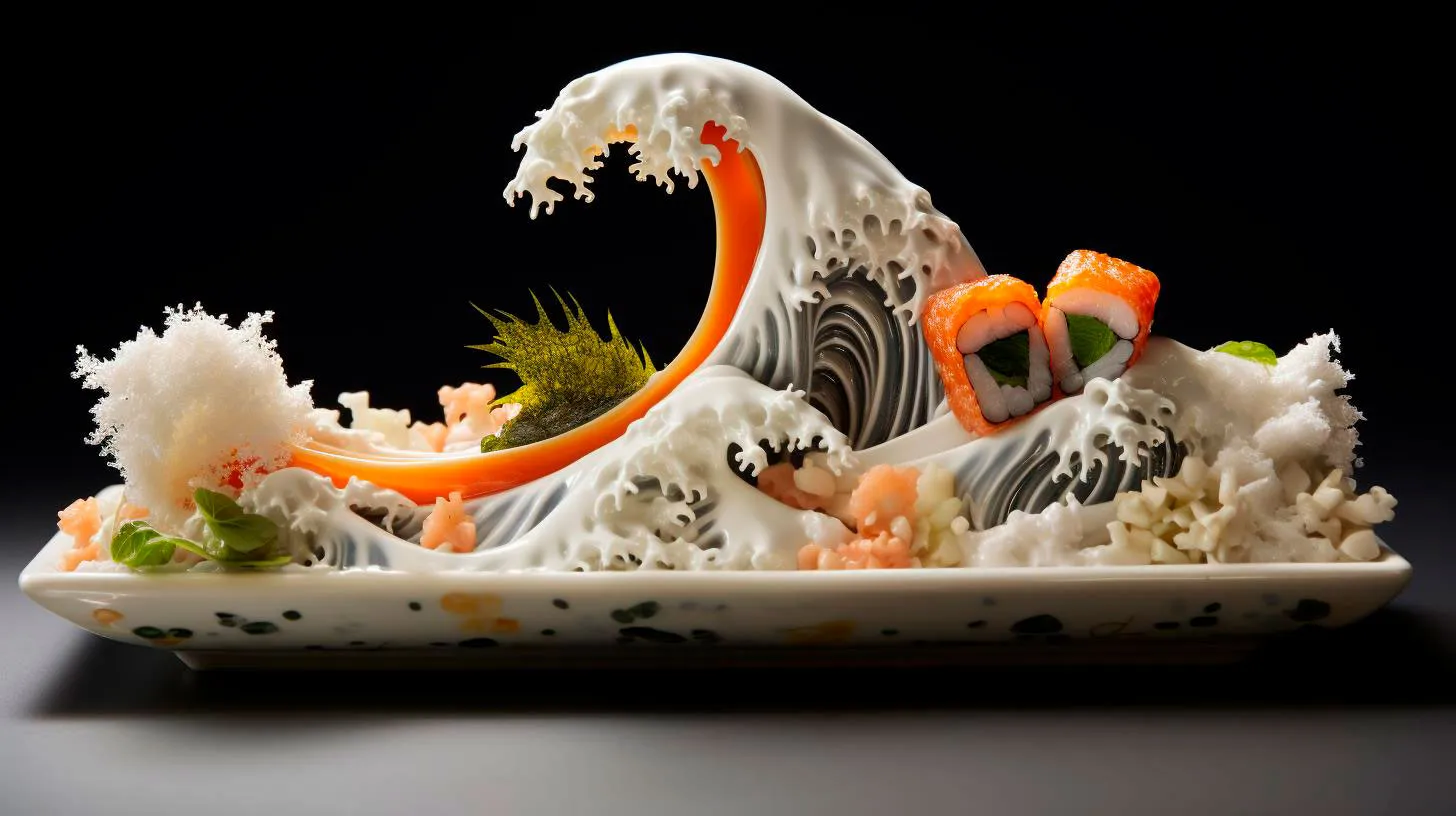Journey into the World of Sushi Masters
The Origins of Sushi
Although sushi has become synonymous with Japanese cuisine, its origins can be traced back to Southeast Asia. In the 2nd century AD, rice was used to preserve the fish by fermenting it. This ancient preservation technique gradually evolved into what we now know as sushi.
During the Edo Period in Japan (1603-1868), sushi gained popularity among the common people. It was during this time that the concept of nigiri sushi, where a slice of fish is placed on a small bed of vinegared rice, was introduced. This became the foundation for modern sushi as we know it today.
The Art of Sushi Making
Mastering the art of sushi making requires years of practice and dedication. Sushi chefs, known as Itamae, undergo rigorous training to hone their skills. They learn about the different varieties of fish, the delicate art of slicing them, and the precise techniques to shape nigiri.
Key Takeaway: The techniques used by sushi masters are crucial in creating sushi of the highest quality. Their precision and attention to detail ensure that every bite is a heavenly experience.
- Knife Skills: Sushi chefs use specialized knives that allow them to slice fish with utmost precision. The ability to cut the fish in the right thickness and angle is essential for achieving the perfect texture and taste.
- Rice Perfection: The rice used in sushi is as important as the fish itself. Itamae master the art of cooking and seasoning rice to achieve the ideal balance of flavors. Each grain must be perfectly cooked and seasoned with the right amount of vinegar.
- Fish Selection: Sourcing the freshest and highest quality fish is a hallmark of sushi masters. They have an in-depth knowledge of various fish species and carefully select those that best complement the flavor of the rice.
The Sushi Culture
Sushi is not merely a meal; it is deeply rooted in Japanese culture. Traditional sushi restaurants often have an intimate and serene ambiance, providing customers with a unique dining experience. From the moment you step into a sushi bar, you are transported into a world of tranquility and precision.
Key Takeaway: The sushi culture emphasizes simplicity and harmony. Every element, from the handcrafted dishes to the elegant presentation, plays a significant role in creating an unforgettable dining experience.
- Omakase: A popular dining style, omakase, meaning “chef’s choice,” allows the sushi master to showcase their creativity. It involves an assortment of chef-selected dishes, providing customers with an opportunity to savor a variety of flavors.
- Sake Pairing: Sushi and sake are a harmonious match. Sushi masters often recommend specific sake varieties to enhance the flavors of the fish and rice. This pairing adds another layer of enjoyment to the dining experience.
- Etiquette: When dining at a sushi bar, it is important to follow certain etiquette. One should use chopsticks or hands instead of utensils, dip sushi lightly in soy sauce, and consume it in one bite. Respecting these customs shows reverence for the sushi tradition.
The Rise of Sushi around the World
Sushi has transcended cultural boundaries and has become a global phenomenon. Today, you can find sushi restaurants in almost every major city worldwide, serving both traditional and fusion sushi dishes.
According to a recent study, the global sushi market is projected to reach a value of $22 billion by 2025, with a compound annual growth rate (CAGR) of 4.1%. This surge in popularity can be attributed to the growing health consciousness and the increasing demand for unique dining experiences.
Key Takeaway: Sushi’s rise to international fame highlights its adaptability and appeal to diverse palates.
- Health Benefits: Sushi is often considered a healthy meal choice due to its low-fat content, high protein content, and omega-3 fatty acids from the fish. It is also rich in vitamins and minerals, making it a popular choice for health-conscious individuals.
- Cultural Fusion: Sushi has seamlessly integrated with different cuisines, giving rise to fusion sushi rolls that incorporate local ingredients and flavors. This cultural fusion has widened the appeal of sushi, attracting a broader range of customers.
- Sustainable Practices: With the increasing focus on sustainable fishing practices, sushi restaurants are now sourcing fish from eco-friendly suppliers. This ensures the longevity of fish populations and supports marine conservation efforts.
Embark on a delightful journey into the world of sushi masters and discover the art, techniques, and cultural significance behind this iconic dish. Whether you are a sushi connoisseur or a curious food enthusiast, the world of sushi is waiting to be explored!
Unforgettable Experiences Shared by ChefsThe Thrill of the Michelin Star
One of the highest honors a chef can achieve is earning a Michelin star. This prestigious accolade recognizes culinary excellence and is highly sought after by chefs worldwide. Chef Thomas Keller, renowned for his restaurants The French Laundry and Per Se, shares his unforgettable experience of receiving three Michelin stars for both his establishments.
- Key Takeaway: Earning a Michelin star is a testament to a chef’s dedication and exceptional culinary skills.
- Industry Statistic: As of 2020, there are only 132 restaurants worldwide with three Michelin stars.
The Power of Collaboration
Collaboration among chefs can lead to extraordinary outcomes. Chef René Redzepi, co-owner of the renowned restaurant Noma, recounts a unique experience where he and his team collaborated with other chefs to create a memorable dining event. This collaboration allowed them to push boundaries, exchange ideas, and offer guests an unforgettable culinary journey.
- Key Takeaway: Collaboration among chefs brings innovative ideas to the table, resulting in extraordinary dining experiences.
- Industry Statistic: According to a survey conducted by The Culinary Institute of America, 78% of chefs believe collaboration enhances creativity and innovation in the culinary world.
The Sweet Taste of Success
For many chefs, winning culinary competitions symbolizes a taste of success. Chef Christina Tosi, the renowned pastry chef and founder of Milk Bar, recalls her unforgettable experience of winning the James Beard Award for Outstanding Pastry Chef. This prestigious recognition not only solidified her status as a leading pastry chef but also opened new doors of opportunities for her career.
- Key Takeaway: Winning culinary competitions can propel chefs to greater heights, bringing recognition and new opportunities.
- Industry Statistic: In 2020, the number of culinary competition TV shows increased by 20% globally, showcasing the rising popularity of such events.
The Magic of Serendipity
Some unforgettable experiences are born out of serendipity. Chef Massimo Bottura, the owner of Osteria Francescana, recounts the story of how an unexpected encounter with a famous musician in his restaurant’s kitchen led to the creation of a unique dish. This serendipitous moment sparked creativity and showcased the beautiful intersection of art and culinary craftsmanship.
- Key Takeaway: Serendipity plays an enchanting role in a chef’s journey, often leading to extraordinary culinary creations.
- Industry Statistic: A study by Harvard Business Review found that embracing serendipity can enhance innovation and creative problem-solving in various industries.
The Joy of Giving Back
Many chefs find fulfillment in using their skills and experiences to give back to the community. Chef José Andrés, known for his philanthropic efforts in disaster relief, shares his unforgettable experience of providing meals to those affected by Hurricane Maria in Puerto Rico. Through his organization World Central Kitchen, Andrés not only fed thousands but also brought hope and support to those in need.
- Key Takeaway: Using culinary expertise for philanthropic endeavors can have a transformative impact on communities in need.
- Industry Statistic: According to the National Restaurant Association, the restaurant industry provided nearly 24 million meals to those affected by natural disasters in 2020.
Conclusion
The culinary world is filled with unforgettable experiences that shape chefs’ careers and leave a lasting impact on both their lives and the lives of those who savor their creations. From earning Michelin stars to embracing serendipity, chefs continue to push boundaries, collaborate, and use their skills to create exceptional dining experiences. These stories from renowned chefs remind us of the passion and dedication that goes into every dish, making the experience of dining truly unforgettable.
Tales from the Sushi Counter
Join us as we share some memorable tales from the sushi counter and unravel the secrets behind this ancient culinary tradition.
The Art of Sushi Making
Sushi, a staple of Japanese cuisine, is much more than just raw fish. It is an art form that requires years of practice to master. The process involves meticulously preparing vinegared rice, selecting the freshest ingredients, and skillfully combining them to create visually stunning and flavorsome bites. The chefs behind the sushi counter are true artisans, embodying precision and attention to detail with every slice and roll.
Key takeaway: Sushi making is a meticulous art form that requires years of practice and attention to detail.
Meeting the Sushi Master
During one of our visits to a renowned sushi restaurant, we had the privilege of meeting a seasoned sushi master. His expertise and passion for his craft were truly inspiring. As he deftly sliced through a piece of fatty tuna, he explained the significance of knife skills in sushi making. Each cut, he explained, was done in a precise manner to enhance the texture and flavor of the fish. It was evident that behind the simplicity of a single piece of sushi lay years of dedication and a profound understanding of the ingredients.
Key takeaway: The sushi master’s expertise and precision are reflected in every aspect of the sushi-making process, from knife skills to ingredient selection.
The Omakase Experience
One exceptional experience we had was trying the Omakase menu, a chef-curated tasting menu that showcases the finest ingredients and flavors. Sitting at the sushi counter, we watched in awe as the chef presented a succession of exquisite sushi creations. With each bite, we savored the distinct flavors and appreciated the delicate balance of textures. It was a truly immersive journey through the chef’s imagination and culinary prowess.
Key takeaway: The Omakase experience allows you to trust the chef’s expertise and enjoy a culinary journey filled with surprise and delight.
Sushi and Health Benefits
Aside from its incredible taste, sushi also offers numerous health benefits. The lean fish used in sushi is high in protein and omega-3 fatty acids, which promote cardiovascular health. The seaweed used to wrap sushi, known as nori, is rich in minerals and antioxidants. Additionally, sushi often incorporates fresh vegetables, providing a nutritious and well-rounded meal.
Key takeaway: Sushi is not only delicious but also offers health benefits such as high protein content, omega-3 fatty acids, and antioxidants.
The Rise of Sushi Popularity
In recent years, sushi has gained immense popularity around the world. According to industry statistics, the global sushi market is expected to reach a market value of $24.74 billion by 2027. This growth can be attributed to the increasing global appreciation for Japanese cuisine, the rise of health-conscious consumers, and the accessibility of sushi through delivery services and casual dining options.
Key takeaway: The global sushi market continues to expand, fueled by growing consumer appreciation for Japanese cuisine and healthier food options.
The Zen of Sushi
Beyond the culinary experience, sitting at the sushi counter allows you to witness the harmony and Zen-like atmosphere that pervades the sushi bar. The focused and serene ambience, coupled with warm hospitality, creates an oasis of tranquility amidst our bustling world. In Japan, sushi chefs often train for years in Zen meditation practices to cultivate inner peace, which is reflected in the way they approach their craft.
Key takeaway: The sushi counter offers a sanctuary-like environment, where you can escape the chaos and experience a sense of calm while enjoying your meal.
Conclusion
In conclusion, the sushi counter is a gateway to a world of flavors, tradition, and artistry. Through our encounters with sushi masters and the unique experiences we’ve had, we’ve gained a deeper appreciation for this ancient culinary practice. Sushi-making is not merely a skill, but a way of life that embodies precision, creativity, and a reverence for nature’s bounty. So next time you find yourself at a sushi counter, take a moment to savor each bite and immerse yourself in the tales that the counter holds.
Behind the Scenes at the Sushi Counter
In this article, we will unveil the secrets and techniques used by sushi chefs to craft those delectable rolls.
1. Precision and Technique
Accuracy and precision are the cornerstones of sushi-making. Sushi chefs undergo rigorous training for years to master the art of sushi preparation. Here are a few techniques used:
- Sushi Rice: It’s essential to create perfectly seasoned sushi rice by balancing the right amount of vinegar, sugar, and salt. The rice should be firm and sticky for easy rolling.
- Fish Selection: Sourcing high-quality, fresh fish is crucial. Sushi chefs pay attention to the color, texture, and aroma of the fish to ensure it meets their expectations.
- Knife Skills: A sushi chef’s knife is their most valuable tool. They spend years mastering their knife skills to make precise cuts and create aesthetically pleasing sushi pieces.
Key Takeaway: Precision is paramount in sushi-making. Mastering techniques like creating the perfect sushi rice, selecting fresh fish, and honing knife skills are essential for a sushi chef.
2. Artistry and Creativity
Sushi is not only a culinary delight but also a work of art. Sushi chefs strive to create visually stunning presentations that appeal to both the eyes and the taste buds. Here’s how they achieve this:
- Garnishing: From delicate flower-shaped carrot slices to vibrant, fresh herbs, garnishing adds texture and flavor to sushi rolls. It also enhances the overall presentation of the dish.
- Rolling Techniques: Sushi chefs use various rolling techniques to create different types of rolls, such as maki, nigiri, and temaki. Each style has its unique characteristics and requires precise execution.
- Color Composition: Sushi chefs carefully select ingredients to achieve a harmonious balance of colors in their rolls. Colorful ingredients not only make the dish visually appealing but also indicate the freshness of the ingredients used.
Key Takeaway: Sushi-making goes beyond taste; it is an art form that requires creativity, attention to detail, and an eye for aesthetics.
3. Hygiene and Food Safety
Food safety and hygiene are of utmost importance at the sushi counter. Sushi chefs adhere to strict cleanliness standards to ensure their customers’ health and well-being. Consider these practices:
- Hand Sanitization: Sushi chefs meticulously wash and sanitize their hands on a regular basis, especially when handling raw fish or rice.
- Temperature Control: Raw fish is highly perishable. Sushi chefs monitor and maintain the proper temperature of their workstations and refrigeration units to prevent bacterial growth.
- Fresh Ingredient Rotation: Stale or spoiled ingredients can ruin the quality of sushi. Sushi chefs diligently rotate their stock to ensure freshness.
Key Takeaway: The sushi counter maintains the highest standards of hygiene and food safety to provide customers with a safe and enjoyable dining experience.
Now that you know what happens behind the scenes at the sushi counter, you can truly appreciate the craftsmanship and dedication that goes into preparing this iconic dish. Next time you savor a piece of sushi, take a moment to admire the precision, artistry, and hygiene that come together to create a truly unforgettable dining experience.


